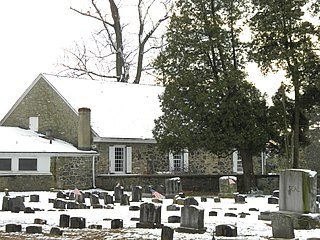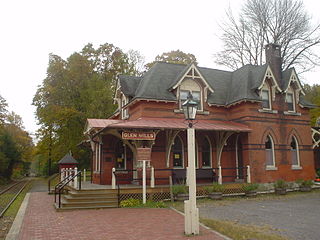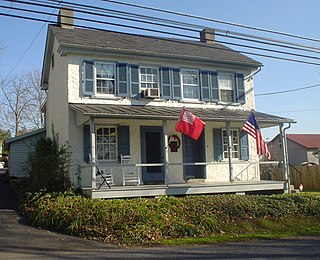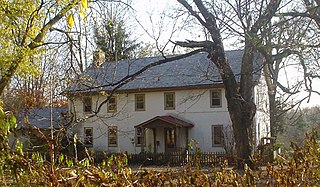
Chester County, colloquially known as Chesco, is a county in the southeastern part of the U.S. state of Pennsylvania. As of the 2020 census, the population was 534,413, increasing by 7.1% from 498,886 in 2010. The county seat and most populated municipality is West Chester. Chester County was one of the three original Pennsylvania counties created by William Penn in 1682. It was named for Chester, England.

Birmingham Township is a township in Chester County, Pennsylvania, United States. The population was 4,208 at the 2010 census.

The Battle of Brandywine, also known as the Battle of Brandywine Creek, was fought between the American Continental Army of General George Washington and the British Army of General Sir William Howe on September 11, 1777, as part of the American Revolutionary War (1775–1783). The forces met near Chadds Ford, Pennsylvania. More troops fought at Brandywine than any other battle of the American Revolution. It was also the second longest single-day battle of the war, after the Battle of Monmouth, with continuous fighting for 11 hours.

Newell Convers Wyeth, known as N. C. Wyeth, was an American artist and illustrator. He was the pupil of artist Howard Pyle and became one of America's greatest illustrators. During his lifetime, Wyeth created more than 3,000 paintings and illustrated 112 books — 25 of them for Scribner's, the Scribner Classics, which is the body of work for which he is best known. The first of these, Treasure Island, was one of his masterpieces and the proceeds paid for his studio. Wyeth was a realist painter at a time when the camera and photography began to compete with his craft. Sometimes seen as melodramatic, his illustrations were designed to be understood quickly. Wyeth, who was both a painter and an illustrator, understood the difference, and said in 1908, "Painting and illustration cannot be mixed—one cannot merge from one into the other."

Brandywine Creek is a tributary of the Christina River in southeastern Pennsylvania and northern Delaware in the United States. The Lower Brandywine is 20.4 miles (32.8 km) long and is a designated Pennsylvania Scenic River with several tributary streams. The East Branch and West Branch of the creek originate within 2 miles (3 km) of each other on the slopes of Welsh Mountain in Honey Brook Township, Pennsylvania, about 20 miles (32 km) northwest of their confluence.

Chadds Ford Township is an affluent township in Delaware County, Pennsylvania. It is located about 25 miles (40 km) southwest of Philadelphia. Prior to 1996, Chadds Ford Township was known as Birmingham Township; the name was changed to allow the township to correspond to both its census-designated place and to distinguish itself from the adjacent Birmingham Township in Chester County. As of the 2010 census, Chadds Ford Township had a population of 3,640, up from 3,170 at the 2000 census.
Chadds Ford is a census-designated place (CDP) in Delaware and Chester counties, Pennsylvania, United States, comprising the unincorporated communities of Chadds Ford and Chadds Ford Knoll. It was first listed as a CDP prior to the 2020 census.

Glen Mills is an unincorporated community in Concord Township, Delaware County, Pennsylvania, United States about 27 miles west of Philadelphia. The ZIP code for Glen Mills is 19342.

The Brandywine School was a style of illustration—as well as an artists colony in Wilmington, Delaware and in Chadds Ford, Pennsylvania, near the Brandywine River—both founded by artist Howard Pyle (1853–1911) at the end of the 19th century. The works produced there were widely published in adventure novels, magazines, and romances in the early 20th century. Pyle’s teachings would influence such notable illustrators as N.C. Wyeth, Maxfield Parrish, and Norman Rockwell. Pyle himself would come to be known as the "Father of American Illustration." Many works related to the Brandywine School may be seen at the Brandywine River Museum of Art, in Chadds Ford.

The Christian C. Sanderson Museum, or simply Sanderson Museum, is a museum of historical artifacts in Chadds Ford, Pennsylvania, United States. It is located in the Chadds Ford Historic District. The items in the museum were collected over many years by Christian C. Sanderson (1882–1966), a teacher, musician, poet, actor, writer, traveler, radio commentator and local historian. The Sanderson Museum was founded in 1967 by his friend and Brandywine artist Andrew Wyeth.
Brandywine Battlefield Historic Site is a National Historical Landmark. The historic park is owned and operated by the Pennsylvania Historical and Museum Commission, on 52 acres (210,000 m2), near Chadds Ford, Delaware County, Pennsylvania in the United States. It is part of the site of the Battle of Brandywine fought on September 11, 1777, during the American Revolution. The Battle of Brandywine covered more than ten square miles, or 35,000 acres. However, the modern park only covers 50 acres which served primarily as the Continental encampment the two days prior to the battle. The battle was a decisive victory for the British and cleared a path directly to the rebel capital of Philadelphia. Brandywine Battlefield Park became a Pennsylvania State Park in 1949 and a National Historic Landmark in 1961.

The N. C. Wyeth House and Studio is a historic house museum and artist's studio on Murphy Road in Chadds Ford Township, Pennsylvania, United States. Beginning with its construction in 1911, it served as the principal home and studio of artist N.C. Wyeth (1882-1945). It was restored to its original appearance around the time of his death. The property is managed by the Brandywine River Museum, which offers tours. It was designated a National Historic Landmark District in 1997.

Old Kennett Meetinghouse is a historic meeting house of the Religious Society of Friends or "Quakers" in Kennett Township near Chadds Ford, Pennsylvania.
George Alexis Weymouth, better known as Frolic Weymouth, was an American artist, whip or stager, and conservationist. He served on the United States Commission of Fine Arts in the 1970s and was a member of the Du Pont family.

Benjamin Ring House is a historic building on the Brandywine Battlefield in Chadds Ford, Pennsylvania. It served as headquarters for General George Washington prior to and during the September 11, 1777 Battle of Brandywine.

The Gilpin Homestead, also known as General Howe Headquarters, is a historic home located in Chadds Ford, Delaware County, Pennsylvania. The original house was built in 1754, and consisted of a brick building with two basement rooms, two first-floor rooms, two bedrooms, and the attic. About 1811, a stone addition was built that is now the middle of the house, and a second stone addition was completed by 1859. A porch was added between 1870 and 1897, and the garage was attached in 1949. Also on the property are a carriage house-barn, small barn, spring house, a creamery-cheese house, and the stone remains of a barn built in 1860. William Howe, 5th Viscount Howe used the Gilpin house as his headquarters from late afternoon of September 11, until the morning of September 16, 1777, after the Battle of Brandywine. The 1754 section was added to an earlier house, probably built in the 1730s. This was eventually torn down to allow for the 19th century additions. There is not, and never was a staircase in the 1754 section, but visible on the plaster wall in the present stair hall, is the "witness" of the original stair. It was added to the National Register of Historic Places in 1971.

The Barns-Brinton House is a historic brick house located between Hamorton and Chadds Ford, Pennsylvania in Pennsbury Township, Chester County, Pennsylvania. It was constructed in 1714 by William Barns who operated it as a tavern from 1722 until his death in 1731. Two owners later, the tract with the house and additional land was purchased by James Brinton. It remained in his family until 1859, then passed through several owners until the property was purchased and restored by the Chadds Ford Historical Society in 1969. Brinton was the owner when the house was in the line of march of Hessian General Wilhelm von Knyphausen on his way to the Battle of Brandywine on behalf of the British in 1777 during the Revolutionary War.

Kuerner Farm, also known as Ring Farm, is a historic farm in Chadds Ford, Pennsylvania, notable for its association with artist Andrew Wyeth, who created about one-third of his work, over 1,000 paintings and drawings, on subjects he found there over a span of 77 years. The farm was listed in the National Register of Historic Places and declared a National Historic Landmark in 2011. The property abuts the Brandywine Battlefield, another National Historic Landmark. The farm is open to public tours, operated by the Brandywine River Museum.

Chadds Ford Historic District is a national historic district located at Chadds Ford Township, Delaware County, Pennsylvania. The district includes 17 contributing buildings in Chadds Ford village. Notable buildings include the Chads Ford Inn (1807-1810), Merchant Mill (1864), a row of houses built between 1840 and 1850, the bridge across Brandywine Creek, and the Christian C. Sanderson Museum. Located in the district are the separately listed Chad House and N. C. Wyeth House and Studio.

Brandywine Summit Camp Meeting is a historic camp meeting and national historic district located at Concord Township, Delaware County, Pennsylvania. The district includes 76 contributing buildings near Chadds Ford village. The buildings are in a vernacular camp meeting style of architecture. The centerpiece of the community are the Tabernacle, built about 1884, and Pavilion, also dated to the 1880s. Most of the contributing buildings are cottages, built after the turn of the 20th century.




















